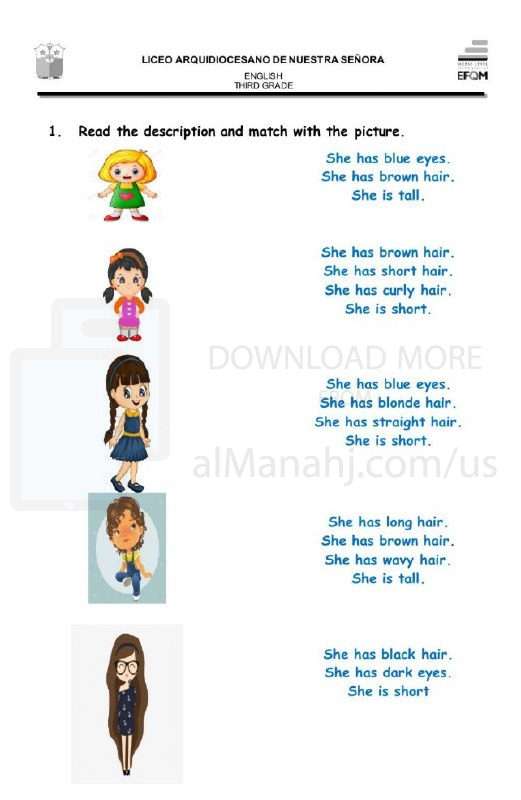| You are here: Almanahj Website ⇒ American curriculum ⇒ 1st Grade ⇒ Physics ⇒ Term 1 | ||
|---|---|---|
Worksheet about Physical description and feelings | ||
|---|---|---|
| Subject: Physics | ||
| 1st Grade | ||
| Term 1 | ||
| Year: 2023/2024 | ||
| Size: 272.8KB | ||
| Number of clicks: 155 | ||
| Publish date:November 08, 2023 | ||
| Added by: Eman | ||
| Last download date: 2024-09-08 17:15:58 | ||
| Updated by: Eman9966 on 2023-11-08 05:39:10 | By: theodor Alejandro Villegas | |
File info: A physical description and feelings worksheet for grade 1 would focus on developing vocabulary related to describing people's appearances and emotions.Here's a description of what such a worksheet might include:1. Physical Description: Provide a list of common physical attributes such as hair color, eye color, height, and clothing. Include accompanying visual representations to help students identify and learn the vocabulary. For each attribute, provide simple questions or prompts that encourage students to describe themselves or others. For example, "What color is your hair?" or "What color are your eyes?" 2. Feelings: Introduce basic emotions such as happy, sad, angry, and surprised. Include visual representations of facial expressions that correspond to each emotion. Use simple sentences or prompts to help students express their own feelings or identify the emotions of others. For example, "How do you feel when you win a game?" or "How do you think the person in the picture is feeling?" 3. Matching Activities: Include matching exercises where students match physical attributes or facial expressions to the corresponding vocabulary words. This can help reinforce their understanding and recognition of different physical descriptions and emotions. 4. Drawing Activities: Provide opportunities for students to draw pictures representing different physical attributes or emotions. For example, they could draw a self-portrait or illustrate a situation that evokes a specific emotion. This exercise encourages creativity and further reinforces their understanding of the concepts. 5. Storytelling or Role-Playing: Engage students in storytelling or role-playing activities where they can describe a character's appearance or express different emotions. This helps develop their language skills and encourages them to use the vocabulary in context. 6. Emotion Recognition: Include activities where students can practice recognizing and identifying emotions in others. Show pictures or scenarios depicting various emotions, and ask students to describe how the person in the picture might be feeling. This helps develop empathy and emotional intelligence. 7. Reflection Questions: Include simple reflection questions that encourage students to think about their own physical appearance and emotions. For example, "What makes you happy?" or "How do you feel when a friend is sad?" These questions promote self-awareness and social-emotional development. It is important to use age-appropriate language and visuals, as well as provide ample opportunities for student participation, such as through discussions, group activities, or sharing sessions. The focus should be on encouraging students to express themselves, develop their vocabulary, and build their understanding of physical descriptions and emotions. | ||
| Downloading link Worksheet about Physical description and feelings |
|---|
|
1699421905.pdf
The file is being prepared for download
|
| File images |
|---|
 |